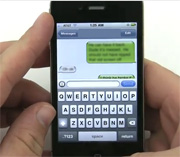- How Daily Prunes Can Influence Cholesterol and Inflammation
- When to Take B12 for Better Absorption and Energy
- Epsom Salts: Health Benefits and Uses
- See What Saffron Can Do for Sleep and Heart Health
- 6 Common Mistakes to Avoid Before Your Physical
- Can Sweating Really Help You Beat a Cold?
- Strengthening Your Relationship: Practical Strategies
- Skip Storing This Everyday Product in the Fridge Door
- Green Tea + B3 Pairing May Boost Brain Health
- Navigating Your Midlife Crisis: Embracing New Possibilities
Lots of Texting, Emailing Going On in College Classrooms


THURSDAY, Oct. 31When they should be listening to their instructors, today’s college students are instead using their phones or tablets 11 times per day while in class, a new study contends.
More than 80 percent of students said they knew that such use of smartphones, tablets and laptops can interfere with their learning. And more than a quarter said their grades suffer as a result, according to the survey of nearly 800 students at six universities in five states.
“I don’t think students necessarily think it’s problematic,” study author Barney McCoy, an associate professor of broadcasting at the University of Nebraska, Lincoln, said in a university news release. “They think it’s part of their lives.”
Overall, 35 percent of the students interviewed said they used digital devices for non-classroom purposes one to three times per day, another 27 percent did so four to 10 times per day, 16 percent did so 11 to 30 times per day and 15 percent did so more than 30 times a day.
Only 8 percent said they never used devices for non-classroom purposes while in class, the study found.
Nearly 86 percent of students said they were texting, 68 percent said they were checking email, 66 percent said they were using social networks, 38 percent said they were surfing the Internet and 8 percent said they were playing a game during class. McCoy said he was surprised to find that 79 percent of the students used their digital devices to check the time.
“That’s a generational thing to me — a lot of young people don’t wear watches,” he said.
Students said the most common disadvantages of using digital devices for non-educational purposes while in the classroom were not paying attention (90 percent), missing instruction (80 percent), being reprimanded by the instructor (32 percent), and losing grade points (more than 25 percent).
Less than 5 percent of students considered it a “very big” or “big” distraction when classmates used digital devices and less than 5 percent believed their own use of a digital device to be a “very big” or “big” distraction.
More than half, however, said they were a “little” distracted when classmates used digital devices, and nearly 46 percent said they were a “little” distracted by their own use of digital devices. Less than 17 percent said the use of digital devices was not a distraction.
The study was published online Oct. 23 in the Journal of Media Education.
More information
The Nemours Foundation offers teens tips for going to college.
Source: HealthDay
Copyright © 2026 HealthDay. All rights reserved.










